Related Research Articles

Fucus vesiculosus, known by the common names bladder wrack, black tang, rockweed, bladder fucus, sea oak, cut weed, dyers fucus, red fucus, and rock wrack is a seaweed found on the coasts of the North Sea, the western Baltic Sea, and the Atlantic and Pacific Oceans. It was the original source of iodine, discovered in 1811, and was used extensively to treat goitre, a swelling of the thyroid gland related to iodine deficiency.
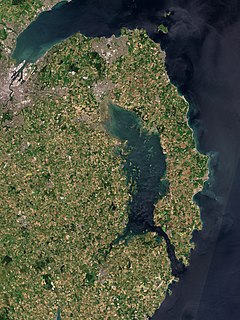
Strangford Lough is a large sea loch or inlet in County Down, in the east of Northern Ireland. It is the largest inlet in the British Isles, covering 150 km2 (58 sq mi). The lough is almost totally enclosed by the Ards Peninsula and is linked to the Irish Sea by a long narrow channel at its southeastern edge. The main body of the lough has at least seventy islands along with many islets (pladdies), bays, coves, headlands and mudflats. Strangford Lough was designated as Northern Ireland's first Marine Conservation Zone (MCZ) under the introduction of the Marine Act 2013. It has also been designated a Special Area of Conservation under the EU Habitats Directive, and its abundant wildlife is recognised internationally for its importance.

Fucus is a genus of brown algae found in the intertidal zones of rocky seashores almost throughout the world.

Ascophyllum nodosum is a large, common cold water seaweed or brown alga (Phaeophyceae) in the family Fucaceae, being the only species in the genus Ascophyllum. It is a seaweed that only grows in the northern Atlantic Ocean, also known in localities as feamainn bhuí, rockweed, Norwegian kelp, knotted kelp, knotted wrack or egg wrack. It is common on the north-western coast of Europe including east Greenland and the north-eastern coast of North America, its range further south of these latitudes being limited by warmer ocean waters.

Fucitol, also known as L-fucitol, 6-deoxy-L-galactitol, and (2R,3S,4R,5S)-hexane-1,2,3,4,5-pentol, is a sugar alcohol derived from fucoidan which is found in the North Atlantic seaweed Fucus vesiculosus or by the reduction of fucose.

Fucus serratus is a seaweed of the north Atlantic Ocean, known as toothed wrack or serrated wrack.

Spirorbis spirorbis is a small (3–4 mm) coiled polychaete that lives attached to seaweeds and eel grass in shallow saltwater.
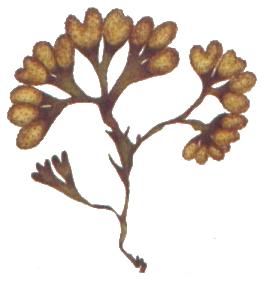
Fucus spiralis is a species of seaweed, a brown alga, living on the littoral shore of the Atlantic coasts of Europe and North America. It has the common names of spiral wrack and flat wrack.

Wrack is part of the common names of several species of seaweed in the family Fucaceae. It may also refer more generally to any seaweeds or seagrasses that wash up on beaches and may accumulate in the wrack zone.
Elsie May Burrows was an English botanist who made significant contributions to British postwar phycology. Her primary area of research was macroalgal ecology, focusing particularly on Fucus, a genus of brown algae, and Chlorophyta, a division of the green algae.
The history of phycology is the history of the scientific study of algae. Human interest in plants as food goes back into the origins of the species and knowledge of algae can be traced back more than two thousand years. However, only in the last three hundred years has that knowledge evolved into a rapidly developing science.
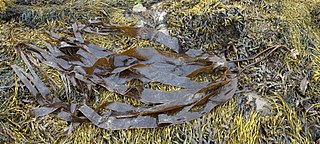
Laminaria digitata is a large brown alga in the family Laminariaceae, also known by the common name oarweed. It is found in the sublittoral zone of the northern Atlantic Ocean.

Fucus distichus or rockweed is a species of brown alga in the family Fucaceae to be found in the intertidal zones of rocky seashores in the Northern Hemisphere, mostly in rock pools.
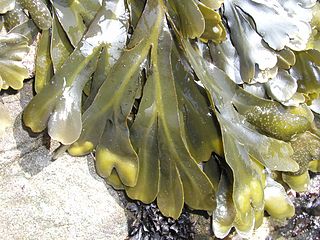
Fucus gardneri is a species of seaweed, a brown alga living on the littoral shore of the Pacific coasts of North America. It has the common names of rockweed and bladderwrack.

Cystoseira baccata is a species of brown seaweed in the family Fucaceae. It is found in the north east Atlantic, the Baltic Sea and the Mediterranean Sea. The species name baccata means "berry-like" and refers to the small air bladders.
Fucus virsoides is a species of brown alga endemic to the Adriatic Sea. The Bay of Kotor was defined as one of the southernmost limits of Fucus virsoides.

Fucus guiryi is a brown alga in the family Fucaceae. It is known from numerous locations along the east coast of the North Atlantic Ocean, from Ireland to the Canary Islands.
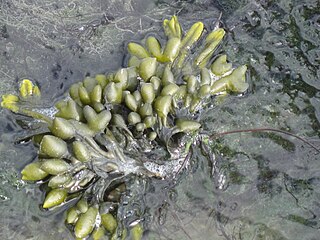
Fucus ceranoides is a species of brown algae found in the littoral zone of the sea shore.

Polysiphonia lanosa is a common species of the red algae (Rhodophyta) often to be found growing on Ascophyllum nodosum.

Coelopa pilipes is a common European species of kelp fly. It was described by A. H. Haliday in 1838. Their appearance differs greatly from that of other Coelopa flies.
References
- ↑ Fletcher, R.L. 1987. Seaweeds of the British Isles Volume 3 Fucophyceae (Phaeophyceae). p. 302. British Museum (Natural History). ISBN 0-565-00992-3
- ↑ Round, F.E. 1965. The Biology of the Algae. p.21. Edward Arnold (Publishers) Ltd
- ↑ Dickinson, C.I. 1963. British Seaweeds. p.101 & 224. The Kew Series